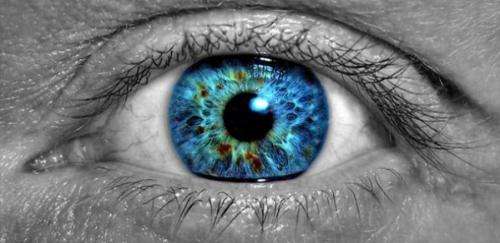Cells from the eye are inkjet-printed for the first time

(Medical Xpress)—A group of researchers from Cambridge have used inkjet printing technology to successfully print cells taken from the eye for the very first time.The breakthrough, which has been detailed in a paper published in IOP Publishing's journal Biofabrication, could lead to the production of artificial tissue grafts made from the variety of cells found in the human retina and may aid in the search to cure blindness.
At the moment the results are preliminary and provide proof-of-principle that an inkjet printer can be used to print two types of cells from the retina of adult rats ― ganglion cells and glial cells. This is the first time the technology has been used successfully to print mature central nervous system cells and the results showed that printed cells remained healthy and retained their ability to survive and grow in culture.
Co-authors of the study, Professor Keith Martin and Dr Barbara Lorber, from the John van Geest Centre for Brain Repair, University of Cambridge, said: "The loss of nerve cells in the retina is a feature of many blinding eye diseases. The retina is an exquisitely organised structure where the precise arrangement of cells in relation to one another is critical for effective visual function".
"Our study has shown, for the first time, that cells derived from the mature central nervous system, the eye, can be printed using a piezoelectric inkjet printer. Although our results are preliminary and much more work is still required, the aim is to develop this technology for use in retinal repair in the future."
The ability to arrange cells into highly defined patterns and structures has recently elevated the use of 3D printing in the biomedical sciences to create cell-based structures for use in regenerative medicine.
In their study, the researchers used a piezoelectric inkjet printer device that ejected the cells through a sub-millimetre diameter nozzle when a specific electrical pulse was applied. They also used high speed video technology to record the printing process with high resolution and optimised their procedures accordingly.
Dr Wen-Kai Hsiao, is a member of the team based at the Department of Engineering's Inkjet Research Centre. He commented: "In order for a fluid to print well from an inkjet print head, its properties, such as viscosity and surface tension, need to conform to a fairly narrow range of values. Adding cells to the fluid complicates its properties significantly."
Once printed, a number of tests were performed on each type of cell to see how many of the cells survived the process and how it affected their ability to survive and grow.
The cells derived from the retina of the rats were retinal ganglion cells, which transmit information from the eye to certain parts of the brain, and glial cells, which provide support and protection for neurons.
"We plan to extend this study to print other cells of the retina and to investigate if light-sensitive photoreceptors can be successfully printed using inkjet technology. In addition, we would like to further develop our printing process to be suitable for commercial, multi-nozzle print heads," Professor Martin concluded.
More information: "Adult rat retinal ganglion cells and glia can be printed by piezoelectric inkjet printing." Barbara Lorber et al. 2014 Biofabrication 6 015001. DOI: 10.1088/1758-5082/6/1/015001


















